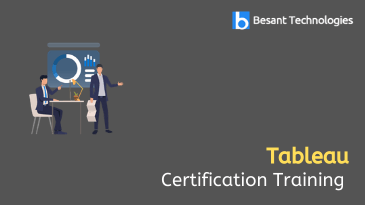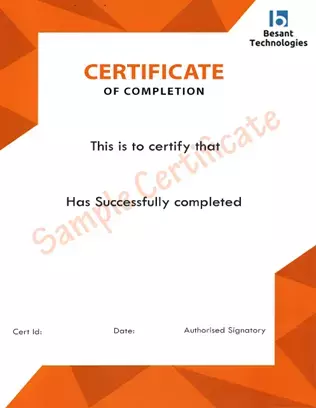Tableau Course Content
Introduction to Data Visualization
Data Visualization is considered as the key field that is mainly implemented and created to represent the data in the graphical format. By this Data Visualization technique, you can clearly map the marks between the data values and the marks on the graph. In Data Visualization you can make use of various visual elements such as maps, charts, graphs, and many more.
These elements help you in understanding the latest trends and outliers of the data. In this module, you will learn in detail about the importance of Data Visualization, latest trends in Data Visualization, types of Data visualizations, gain in-depth knowledge about various Data Visualization techniques, gain knowledge about various visual elements and their functioning, various Data Visualization tools, and key benefits of Data Visualization.
Introduction to Tableau
Tableau is considered as one of the most prominent Data Visualization tools that are mainly used in the Business Intelligence Industry. In Data Visualization you can make use of various visual elements such as maps, charts, graphs, and many more. These elements help you in understanding the latest trends and outliers of the data. Data analysis can be performed easily by using the Tableau and represent the final data outputs in the form of worksheets and dashboards. End-users can create their own interactive worksheets and dashboards and can share with their team in an organization.
In this module, you will gain in-depth knowledge about the concepts like Introduction to Business Intelligence, what is Data Analysis, introduction to Tableau, gain in-depth knowledge about Tableau Desktop, Tableau Server, what are the components of Tableau Server, understanding about Tableau Software, uses of Tableau Software, components of the dashboard in Tableau, learn in detail about the importance of Data Visualization, latest trends in Data Visualization, types of Data visualizations, gain in-depth knowledge about various Data Visualization techniques, key components of Tableau, and the key features of Tableau.
Architecture of Tableau
Tableau is considered as one of the most prominent Data Visualization tools that are mainly used in the Business Intelligence Industry. Data analysis can be performed easily by using the Tableau and represent the final data outputs in the form of worksheets and dashboards. End-users can create their own interactive worksheets and dashboards and can share with their team in an organization.
In this module, you will gain a better understanding of the concepts like an introduction to Tableau, the architecture of Tableau, Tableau Server architecture components, data server in Tableau, what is Load Balancer in Tableau, what is Tableau data strategy, gain knowledge about Tableau authorization and authentication, the architecture of Tableau Server, understanding about Data Pane, how to install Tableau, how to start with Tableau, introduction to Tableau Desktop, and the architecture of Tableau Desktop.
Creation of Sets
What is a set in Tableau, understand dynamic sets in Tableau, what are groups in Tableau, comparison between the Tableau sets and groups, how to create set in Tableau using a formula, tableau sets in calculated fields, how to create sets in tableau from multiple dimensions, what are the parameters in Tableau, what is Tableau custom value list, Tableau intersection of sets, what is metadata, Tableau multiple groups, what is a hierarchical field in Tableau, how to create segments in Tableau, comparison between sets and bins in Tableau, comparison between set and parameter in Tableau, need of sets in Tableau, what are the user input parameters in Tableau, and advantages of using sets in Tableau.
Working with Filters
Filters in Tableau are mainly used to modify the data in the local copies of the data sets which are extracted from the main data source. The filters present in the Data source modify the data based on the given conditions. you will learn in detail about the importance of filters in Tableau, different types of filters available in Tableau, what are the context filters in Tableau, what are the extract filters in Tableau, understand the order of filters in Tableau, what is the hierarchy of filters in Tableau, what are the conditional filters in Tableau, comparison between data source filters and extract filters in Tableau, quick filters in Tableau, how to make use of different filters available in Tableau, What are the difference between filters and parameters in Tableau, and what are the action filters in Tableau.
Working with Parameters
Parameters are considered as the dynamic values in Tableau that are mainly used to replace filters, reference lines, and calculations. what are the parameters, how to create parameters in Tableau, how to make use of parameters in calculation, column section parameters, how to make use of parameters in filters section, chart selection parameters, how to make use of parameters in reference line, how to make use of parameters in calculated fields, how to create various new parameters, how to pass parameters to filters, What are the difference between filters and parameters in Tableau, what are the date parameters in Tableau, and parameter use cases in Tableau?
Working with Expressions and Calculations
What are the expressions in Tableau, gain in-depth knowledge about the Level of Detail expressions in Tableau, how expressions allow you to compute the values at visualization level and data source level, syntax and usage of Level of Detail (LOD) expressions in Tableau, different levels of LOD expressions, higher level, fixed level, lower level, level of granularity, what is Nested LOD in Tableau, what are the advanced LOD calculations in Tableau, what is include LOD in Tableau, understand Tableau LOD if statement, what are the fixed functions in Tableau, how to compute aggregations using LOD expressions, how to create a calculated field in Tableau, types of calculations in Tableau, different types of table calculations in Tableau, vlookups in Tableau, what are the Tableau calculated field functions, what are the Tableau calculated field filters, how to create the calculated fields, what are the predefined calculations in Tableau, replication, and knowledge about calculation syntax in Tableau.
Working with Mapping
Introduction to Tableau, how to build a simple map in Tableau, how to present your data on a map, what is a map view in Tableau, what are the different types of maps you can build in Tableau, understanding flow maps, proportional symbol maps, Visual Clusters of data, how to create paths between origin and destination using mapping, how to format your geographical fields, how to customize your map looks in Tableau, how to use Web Map Service (WMS) servers, how to blend the geographical data, how to present quantitative values in Tableau using mapping, geographic data analysis in Tableau, how to explore data in maps, Map Image Storing, and what is Mapping Workspace.
Graphs and Charts
In Data Visualization you can make use of various visual elements such as maps, charts, graphs, and many more. These elements help you in understanding the latest trends and outliers of the data. In this module, you will learn in detail about the importance of Data Visualization, latest trends in Data Visualization, types of Data visualizations, the importance of visual elements in Tableau, visual elements key functions, knowledge about histograms, what are scattered plots, treemaps, different chart types, what are the Tableau essentials, Bar charts, Line graphs in Tableau, Gnatt charts, Waterfall charts, how to plot a graph in Tableau, what are the different statistical graphs in Tableau, Pareto charts, different types of visuals, and advantages of using charts and graphs in Tableau.
Integration of Tableau with Hadoop and R
Introduction to Tableau, need of R programming language, introduction to Hadoop language, basics of R programming language, how to create a function in R language, what are the use cases available in Hadoop and R programming language, how to integrate Tableau with R, how to integrate Tableau with Hadoop, how to deploy R on the Tableau, importance of R language on Tableau platform, key concepts in R programming language, key concepts in Hadoop, and what are the benefits of integrating Tableau with Hadoop language and R programming language.
Stories and Dashboards
Tableau’s story is considered as the sequence of visualization that makes users work together to convey the information. You can create your own stories to narrate the data and to provide hidden as well as in-depth insights of data. Moreover, you make the decision to relate the data insights with the outcome, how to make use of stories in Tableau, how to insert an image in the Tableau story, how to create a story in Tableau, what is the main difference between dashboard and story in Tableau, what is a Tableau dashboard, what is a Tableau Workbook, how to create a dashboard in Tableau, how to create interactive dashboard in Tableau, how to monitor data using dashboard simultaneously, and how to put all the multiple elements of different workbooks on single dashboard.
Tableau Prep
What is a Tableau Prep, what are the two types of Tableau preps, prep conductor, knowledge about prep conductor, what are the major differences between Tableau prep and Tableau, what the Tableau prep builder do, ETL tool, how to clean data using Tableau prep builder, how to install and download Tableau prep, how to make use of Tableau prep builder and prep conductor, data preparation using Tableau prep, what are the different versions available in Tableau prep, and get deeper insights of data by using Tableau prep?
Data Blending
Data Blending is the most prominent feature in Tableau. This data blending is mainly used to relate the data from different data sources. What is data blending in Tableau, what is joining in Tableau, what are the major differences between the data blending and data joining in Tableau, how you can blend in Tableau, what are the limitations of data blending in Tableau, how to make use of data from two different sources, learn how to combine relevant data from data sources in Tableau, how to blend data on worksheets, and what are the rules to be followed while data blending in Tableau?
Working with Metadata
Introduction to Tableau, what is metadata in Tableau, how to start with metadata in Tableau, the need for metadata in Tableau, how to manage metadata in Tableau, how to edit metadata in Tableau, what is a data interpreter in Tableau, what are the different file extensions available in Tableau, how to pivot data in Tableau, how to blend data in Tableau, how to take control/action of your metadata in Tableau, what are the different metadata models available in Tableau, what is the Tableau metadata API, what is a metadata grid in Tableau, how to customize your data sources in Tableau using metadata management, and how to edit the different data connections in Tableau.













